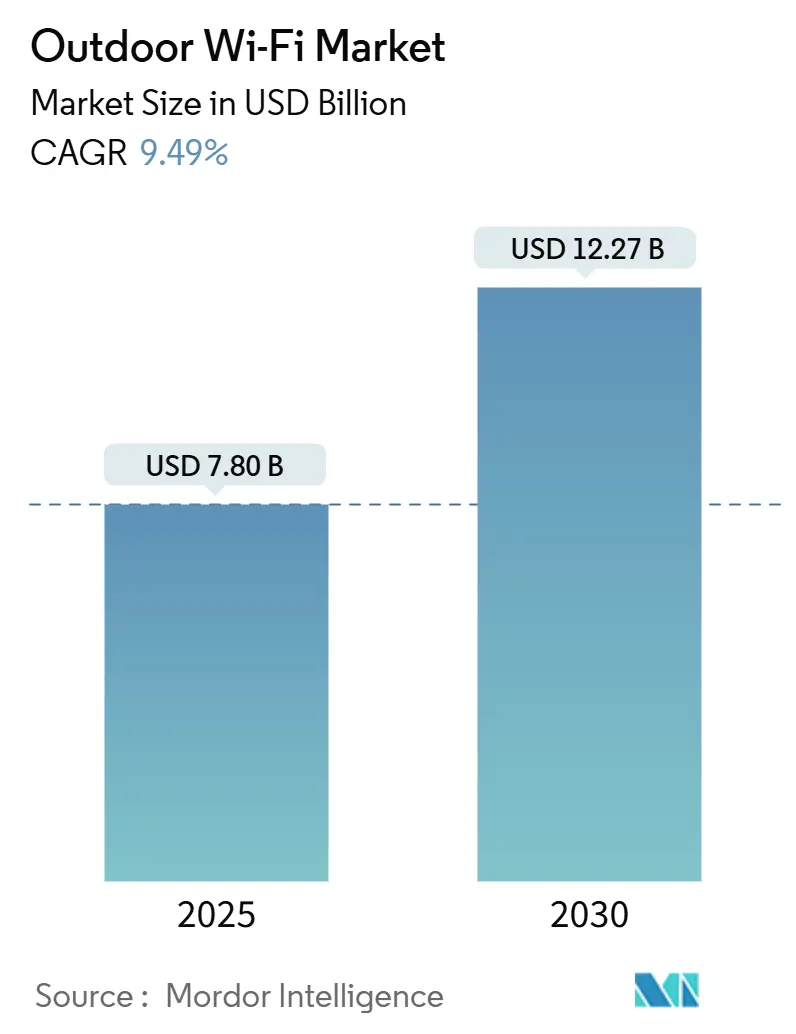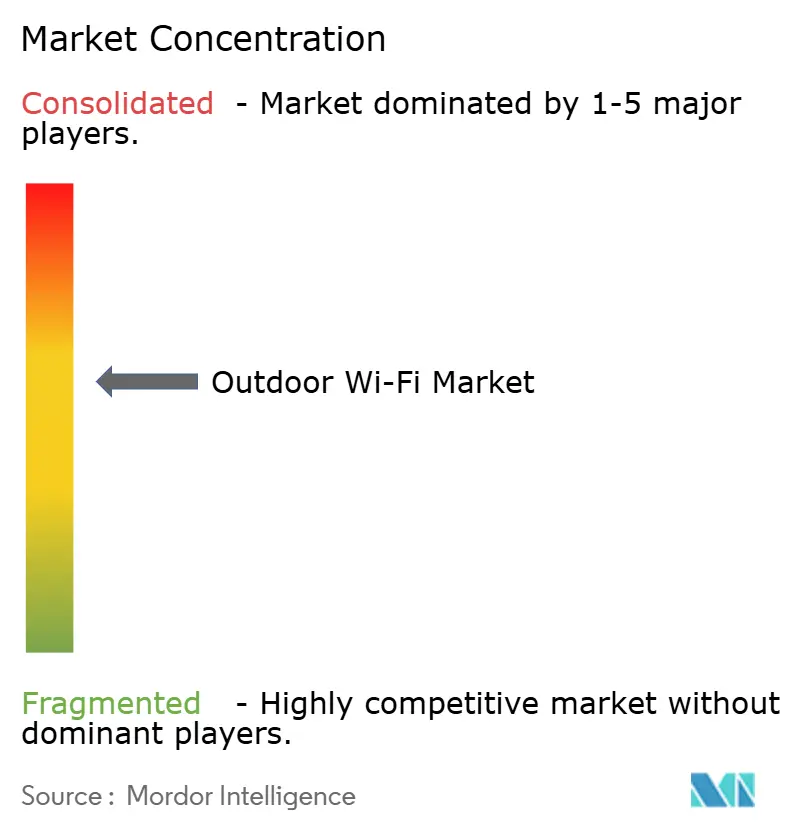Outdoor Wi-Fi Market Size and Share

Outdoor Wi-Fi Market Analysis by Mordor Intelligence
The Outdoor Wi-Fi market size is USD 7.80 billion in 2025 and, at a 9.49% CAGR, is poised to reach USD 12.27 billion by 2030. Continued evolution from simple hotspots to strategic, IoT-ready infrastructure elevates outdoor connectivity into a core layer of municipal and enterprise digital transformation. Accelerating deployments across smart-city corridors, transportation hubs, and heavy-industry sites support steady capital expenditure, while Wi-Fi 6/6E and early Wi-Fi 7 rollouts enhance spectrum efficiency and device density. Vendors differentiate through AI-native management, ruggedized hardware, and integrated security features that align with rising compliance mandates. Climate-hardening requirements, spectrum congestion, and privacy legislation temper roll-out speeds, steering demand toward managed-service models and holistic solution providers. Regional momentum is bifurcated: North America sustains leadership through mature smart-city budgets and 6 GHz regulatory frameworks, while Asia-Pacific fuels incremental volume through urbanization programs and government-sponsored digitization.
Key Report Takeaways
- By product category, access points led with 48.72% revenue share in 2024 in the outdoor Wi-Fi market; outdoor wireless bridges are projected to expand at a 10.35% CAGR through 2030.
- By service, installation and support accounted for 52.62% of the outdoor Wi-Fi market share in 2024, while managed services record the fastest trajectory at 10.45% CAGR through 2030.
- By implementation model, traditional outdoor hotspots commanded 57.74% of the outdoor Wi-Fi market size in 2024; IoT backhaul networks are forecast to rise at a 10.68% CAGR to 2030.
- By end-user industry, smart cities and municipalities captured 34.92% revenue share in 2024 in the outdoor Wi-Fi market, whereas oil and gas/mining is advancing at a 9.98% CAGR between 2025-2030.
- By geography, North America maintained a 38.73% share in 2024 in the outdoor Wi-Fi market; Asia-Pacific is set to accelerate at a 10.02% CAGR through 2030.
Global Outdoor Wi-Fi Market Trends and Insights
Drivers Impact Analysis
| Driver | (~) % Impact on CAGR Forecast | Geographic Relevance | Impact Timeline |
|---|---|---|---|
| Explosive growth of IoT edge devices | +2.1% | Global, with APAC leading adoption | Medium term (2-4 years) |
| Rapid roll-out of smart-city Wi-Fi projects | +1.8% | North America and EU, expanding to APAC | Short term (≤ 2 years) |
| Transportation-hub demand for seamless connectivity | +1.4% | Global, concentrated in major metropolitan areas | Medium term (2-4 years) |
| Wi-Fi 6/6E as cost-effective 5G offload | +1.7% | North America and EU, with regulatory variations | Short term (≤ 2 years) |
| EV-charging stations bundling outdoor Wi-Fi | +0.9% | North America and EU primarily | Long term (≥ 4 years) |
| Wi-Fi HaLow-enabled long-range industrial sensing | +1.2% | Global, with industrial concentration | Long term (≥ 4 years) |
| Source: Mordor Intelligence | |||
Explosive Growth of IoT Edge Devices
Billions of low-power sensors require continuous, cost-effective outdoor coverage, shifting architecture from user-centric hotspots to machine-centric grids. Qualcomm’s 2024 alliance with STMicro embeds tri-radio SoCs and on-board AI in MCU modules, enabling outdoor access points to handle thousands of concurrent links. Milesight and Morse Micro validated sub-1 GHz Wi-Fi HaLow for long-range smart-city sensing, underscoring the Outdoor Wi-Fi market pivot toward extended-range, low-energy backhaul. Device density intensifies demand for APs with optimized receive sensitivity, advanced scheduling, and cloud analytics that pre-empt congestion.
Rapid Roll-out of Smart-City Wi-Fi Projects
Municipal budgets increasingly earmark outdoor connectivity as critical infrastructure. Calix’s Passpoint-driven SmartTown Alliance delivered 75% connectivity gains and 3% ARPU uplift for U.S. rural broadband providers in 2024.[1]Calix Press Office, “Calix SmartTown Alliance Extends Secure Wi-Fi,” calix.com Extreme Networks’ Rome deployment and Huawei-Telconet’s 1,700-AP Ecuador rollout illustrate the scale and diversity of municipal initiatives. Such programs anchor long-term service contracts, foster public-private funding models, and catalyze adoption of AI-native network operations platforms that slash field-maintenance cycles.
Transportation-Hub Demand for Seamless Connectivity
Airports, rail terminals, and bus interchanges extend passenger experience beyond indoor concourses. Boingo broadened footprints at O’Hare and Las Vegas, integrating outdoor APs with private LTE, DAS, and neutral-host 5G fabrics. Seoul’s subway Wi-Fi corridors illustrate transit agencies’ move toward platform-to-street continuity, while LAX’s open RFP signals competitive stakes for large-venue contracts. Connectivity bundles now incorporate asset-tracking, curbside ride-share orchestration, and EV-charging telemetry, positioning the Outdoor Wi-Fi market as an operational backbone for multimodal mobility.
Wi-Fi 6/6E as Cost-Effective 5G Offload
Operators leverage six-gigahertz spectrum and OFDMA to divert high-density traffic from costly mid-band 5G. The Wi-Fi Alliance found that Wi-Fi already transports 80% of indoor data; extending this paradigm outdoors curbs RAN capital intensity. Juniper’s ruggedized AP64 and Extreme’s 6E certifications showcase hardware readiness, though AFC approval gates full-power outdoor launches in the United States of America.[2]Jeff Aaron, “Juniper announces outdoor Wi-Fi 6E AP,” juniper.net Convergence with Wi-Fi 7 and 5G network slicing enables differentiated latency tiers for AR wayfinding and real-time security feeds, reinforcing the Outdoor Wi-Fi market’s strategic relevance.
Restraints Impact Analysis
| Restraint | (~) % Impact on CAGR Forecast | Geographic Relevance | Impact Timeline |
|---|---|---|---|
| Escalating security and privacy concerns | -1.3% | Global, with heightened EU regulatory focus | Short term (≤ 2 years) |
| Spectrum congestion and RF interference | -0.9% | Dense urban areas globally | Medium term (2-4 years) |
| Climate-hardening costs for rugged APs | -0.7% | Extreme climate regions globally | Long term (≥ 4 years) |
| Country-specific EIRP limits curbing range | -0.6% | EU and regulated markets | Medium term (2-4 years) |
| Source: Mordor Intelligence | |||
Escalating Security and Privacy Concerns
Mandatory WPA3, GDPR compliance, and zero-trust mandates heighten deployment complexity. Outdoor topologies lack physical perimeter controls, making identity-centric policies and AI-driven anomaly detection essential. Juniper’s Mist embeds machine-learning threat scoring to automate containment, while healthcare campus rollouts illustrate HIPAA-grade encryption requirements for outdoor patient zones. Regulatory scrutiny, particularly in Europe, raises audit costs yet spurs demand for integrated security stacks, favoring vendors that bundle policy engines, SASE on-ramps, and edge firewalls.
Spectrum Congestion and RF Interference
Urban canyons witness mounting co-channel contention as Wi-Fi, 5G fixed wireless, and private LTE vie for spectrum. CableLabs warned that 6 GHz channels could saturate within five years at current AP densities, compelling reliance on dynamic power control and interference-aware mesh routing. Automated Frequency Coordination adds operational overhead but mitigates incumbent-protection risks. Intelligent spectrum analytics, beam-steering antennas, and AI-optimized channel plans are emerging prerequisites for sustained Outdoor Wi-Fi market performance.
Segment Analysis
By Product: Access Points Anchor a Diversifying Portfolio
Access Points generated 48.72% of 2024 revenue, underlining their centrality to the Outdoor Wi-Fi market size. Multi-radio, IP67-rated units with integrated edge compute now support concurrent client traffic and IoT backhaul, blending user and machine workloads. Rugged designs withstand temperature swings and moisture, while cloud telemetry enables predictive maintenance. Juniper, Extreme Networks, and Cisco refresh portfolios with Wi-Fi 6E/7 radios, tri-band scanning, and integrated GPS for location services. Growing client capacity aligns with smart-city sensor surges, cementing Access Points as the nexus of outdoor digital infrastructure.
Outdoor Wireless Bridges, advancing at a 10.35% CAGR, respond to industrial point-to-point video, backhaul for 5G small cells, and fiber-replacement in budget-sensitive regions. Ceragon’s planned integration of Siklu expands millimeter-wave options, pushing multi-gigabit throughput over 2-kilometer links. The Outdoor Wi-Fi market benefits as bridge vendors embed Wi-Fi radios for rapid mesh formation, reducing truck rolls and time-to-service. Controllers and hotspot gateways retain niche relevance where centralized session management or captive portals remain in force, particularly across hospitality and transport hubs.

Note: Segment shares of all individual segments available upon report purchase
By Service: Managed Offerings Accelerate Operational Efficiency
Installation and Support services held 52.62% share in 2024, reflecting the labor-intensive nature of pole mounts, cabling, and RF tuning. Yet Managed Services are forecast to expand 10.45% annually, mirroring enterprises’ lean IT staffing and the complexity of multi-site, multi-vendor ecosystems. Managed providers bundle 24×7 monitoring, over-the-air firmware, and compliance reporting, slashing mean-time-to-repair and CapEx risk. The Outdoor Wi-Fi industry sees telcos extending NOC capabilities into subscription-based Wi-Fi operations, while MSPs such as Calix’s SmartTown Alliance pool footprints for rural economies of scale.
Network Planning and Design persists as a consultative growth niche, incorporating 3-D RF modeling, LiDAR-based obstructions, and spectrum coexistence simulations for 6 GHz AFC. Training and Consulting fill a widening skills gap, focusing on AI-driven troubleshooting, security posture hardening, and cross-domain orchestration that blends Wi-Fi with private 5G.
By Implementation Model: IoT Backhaul Networks Redefine Architecture
Outdoor Hotspots still represent 57.74% of today’s Outdoor Wi-Fi market size, covering parks, plazas, and retail forecourts. However, IoT Backhaul Networks are climbing 10.68% per year, reflecting sensor-dense smart-city grids and industrial telemetry. Wi-Fi HaLow’s sub-1 GHz links extend connectivity across warehouses, mining pits, and farmland; Edgecore’s EAP112 launch underscores commercial availability. Private outdoor networks proliferate across campuses that require deterministic latency and on-prem data sovereignty, while community mesh solutions tap government subsidies to bridge digital divides.
Community Wi-Fi meshes, powered by solar poles and partner backhaul, provide last-meter access for underserved populations. Edge analytics at APs prioritizes low-bandwidth sensor traffic, while tiered QoS ensures equitable consumer internet. The Outdoor Wi-Fi market thus converges toward hybrid topologies combining public access, private slices, and low-power backhaul within a unified management plane.

Note: Segment shares of all individual segments available upon report purchase
By End-User Industry: Industrial Verticals Accelerate Digital Field Operations
Smart Cities and Municipalities controlled 34.92% revenue in 2024, leveraging outdoor networks for traffic analytics, environmental monitoring, and citizen portals. Municipal CIOs increasingly award multi-year contracts with performance-based SLAs that tie uptime to service payments. Oil and Gas/Mining is the fastest-growing vertical at 9.98% CAGR, deploying rugged Wi-Fi for real-time equipment telemetry, worker safety tracking, and autonomous vehicle guidance. Saudi Aramco’s adoption of outdoor mesh backbones highlights resource-sector demand for telemetry in corrosive, remote environments.
Education and Healthcare institutions extend coverage to courtyards, stadiums, and temporary triage tents, boosting patient engagement and hybrid learning. Logistics operators wire distribution yards for yard-management systems and gate automation, intertwining Wi-Fi with RFID and UWB. Retailers favor curbside fulfillment and parking-lot engagement, while Public Utilities overlay Wi-Fi on smart grids, water meters, and street-light poles, embedding connectivity into critical infrastructure, a growing slice of the Outdoor Wi-Fi market.
Geography Analysis
North America, with 38.73% revenue in 2024, capitalizes on longstanding broadband initiatives, smart-city grants, and 6 GHz spectrum clarity. Projects such as Aldine ISD’s 8,000-AP rollout underscore education’s role in volume deployments. Airport consortia, utility cooperatives, and hospital systems sustain strong pipeline demand. The Outdoor Wi-Fi market here still faces spectrum-coordination bottlenecks as the FCC finalizes AFC rules for standard-power 6 GHz, but vendor readiness and public funding mitigate adoption headwinds.
Asia-Pacific is the Outdoor Wi-Fi market’s growth engine, advancing 10.02% CAGR. Massive urbanization in China, India, and Southeast Asia drives municipal connectivity, while Japan pioneers Wi-Fi 7 pilots and OpenRoaming adoption. National spectrum allocations expedite deployments, and governmental digitization mandates encourage multivendor participation. Investments by carriers such as Claro Brasil (USD 7.7 billion through 2029) signal large-scale outdoor wireless expansion. Government-backed rural broadband, including Huawei’s Smart Village Showcase in Zambia, illustrates use cases beyond dense metros, extending Outdoor Wi-Fi market reach into agrarian communities.
Europe registers steady yet regulation-focused expansion. GDPR, AI Act provisions, and ETSI power limits influence design choices, prompting privacy-centric zero-trust architectures. Early OpenRoaming projects in Belgium and London demonstrate traction for seamless authentication models. Public-private partnerships bolster deployments in transport corridors and historical districts, balancing heritage preservation with modern connectivity. South America and the Middle East and Africa remain emerging but strategic, fueled by government connectivity targets. Morocco’s 25% 5G coverage goal by 2025 positions Outdoor Wi-Fi as complementary offload. Satellite-backhauled Wi-Fi, illustrated by Gilat’s USD 3 million Latin American contract, extends reach in sparsely populated zones.[3]Gilat SATCOM, “Gilat awarded follow-on order for Latin America,” gilat.com

Competitive Landscape
The Outdoor Wi-Fi market features moderate fragmentation, with no single vendor exceeding a one-third revenue share. Cisco, HPE-Aruba-Juniper, and Cambium anchor the top tier, leveraging enterprise channels, AI-driven cloud management, and extensive field services. HPE’s USD 14 billion Juniper acquisition consolidates Aruba’s portfolio with Mist’s AIops, intensifying competition with Cisco and enabling broader outdoor SKUs. The DOJ-mandated divestiture of Aruba Instant On creates white-label opportunities for mid-tier providers, potentially redistributing market influence.
Specialists such as Ubiquiti, Ruckus (CommScope), and Cambium emphasize price-performance and community-mesh features, targeting municipalities and WISPs. Amphenol’s acquisition of CommScope’s outdoor networks unit repositions passive infrastructure under a connectivity conglomerate, suggesting vertical integration synergies for antennas and enclosures. Emerging innovators like Edgecore and Morse Micro commercialize Wi-Fi HaLow, carving niches in low-power IoT backhaul. Managed-service aggregators integrate multi-vendor estates, fueling service-led differentiation.
Strategic moves revolve around portfolio expansion, AI-native platforms, and geographic diversification. Integration of satellite backhaul (ANTlabs–Starlink), tower partnerships (Millicom–SBA), and microwave backhaul acquisitions (Ceragon–Siklu) underscore cross-domain convergence. Vendors that marry rugged hardware with predictive analytics, SASE, and open-roaming federation are positioned to seize the Outdoor Wi-Fi market’s next growth wave.
Outdoor Wi-Fi Industry Leaders
-
Aerohive Networks LLC
-
Airspan Networks Holdings Inc.
-
Alvarion Technologies Ltd.
-
Cisco Systems, Inc.
-
Fortinet, Inc.
- *Disclaimer: Major Players sorted in no particular order

Recent Industry Developments
- March 2025: Huawei and Zambia’s Ministry of Technology and Science inaugurated the Global Smart Village Showcase, deploying RuralStar base stations and outdoor Wi-Fi within 30 days to enable e-health and e-education.
- January 2025: HPE completed its USD 14 billion Juniper Networks acquisition, agreeing to divest Instant On and license Mist AIOps code to settle DOJ concerns.
- October 2024: Calix launched the SmartTown Alliance, enabling broadband providers to share Passpoint-secured outdoor Wi-Fi; early members reported 75% traffic gains and 3% ARPU uplift.
- October 2024: Millicom and SBA Communications sealed a USD 975 million tower partnership across Central America, covering 7,000 sites and up to 2,500 build-to-suit additions.
Global Outdoor Wi-Fi Market Report Scope
Wi-Fi technology is crucial for various systems, such as Machine to Machine (M2M) and Hot Spots. Outdoor Wi-Fi technology is emerging across multiple verticals, such as healthcare, education, shopping malls, the public sector, railway stations, and airports. The scope also comprises Products and Services.
The Global Outdoor Wi-Fi Market is segmented by product (WLAN controllers, access points, and wireless hotspot gateways), service (network planning and design and installation and support), implementation model (outdoor hotspots and private networks), end-user industry (healthcare, education, logistics and transportation, travel and hospitality, public utilities, and other end-user industries), and geography(North America, Europe, Asia Pacific, Latin America, Middle East, and Africa).
The market sizes and forecasts are in value (USD) for all the above segments.
| WLAN Controllers |
| Access Points |
| Outdoor Wireless Bridges |
| Wireless Hotspot Gateways |
| Network Planning and Design |
| Installation and Support |
| Managed Services |
| Training and Consulting |
| Outdoor Hotspots |
| Private Networks |
| Community Wi-Fi Mesh |
| IoT Backhaul Networks |
| Healthcare |
| Education |
| Logistics and Transportation |
| Travel and Hospitality |
| Public Utilities |
| Smart Cities and Municipalities |
| Retail |
| Oil and Gas / Mining |
| Other End-user Industries |
| North America |
| South America |
| Europe |
| Asia-Pacific |
| Middle East and Africa |
| By Product | WLAN Controllers |
| Access Points | |
| Outdoor Wireless Bridges | |
| Wireless Hotspot Gateways | |
| By Service | Network Planning and Design |
| Installation and Support | |
| Managed Services | |
| Training and Consulting | |
| By Implementation Model | Outdoor Hotspots |
| Private Networks | |
| Community Wi-Fi Mesh | |
| IoT Backhaul Networks | |
| By End-user Industry | Healthcare |
| Education | |
| Logistics and Transportation | |
| Travel and Hospitality | |
| Public Utilities | |
| Smart Cities and Municipalities | |
| Retail | |
| Oil and Gas / Mining | |
| Other End-user Industries | |
| By Geography | North America |
| South America | |
| Europe | |
| Asia-Pacific | |
| Middle East and Africa |
Key Questions Answered in the Report
What is the Outdoor Wi-Fi market outlook through 2030?
The Outdoor Wi-Fi market size should climb from USD 7.80 billion in 2025 to roughly USD 12.27 billion by 2030, reflecting a 9.49% CAGR driven by smart-city adoption and IoT backhaul demand.
Which product type dominates Outdoor Wi-Fi deployments?
Access Points hold nearly 49% revenue share due to their versatility in user connectivity and IoT support.
Which region will grow fastest in Outdoor Wi-Fi?
Asia-Pacific is set to expand at about 10% CAGR on the back of urbanization and government digitization mandates.
Why are managed services gaining traction?
Complex multi-site outdoor networks require 24×7 monitoring and rapid firmware updates, so enterprises increasingly outsource operations to managed-service providers offering AI-driven automation.
How does Wi-Fi 6E influence outdoor connectivity?
Six-gigahertz spectrum and OFDMA features make Wi-Fi 6E a cost-efficient offload for 5G, enabling higher throughput and lower latency in dense outdoor venues.
Page last updated on:



